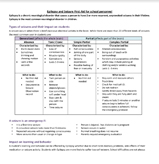Epilepsy Basics
Frequently Asked Questions about Epilepsy
Epilepsy, which is sometimes called a seizure disorder, is a disorder of the brain. A person is diagnosed with epilepsy when they have had two or more seizures.
A seizure is a short change in normal brain activity.
Seizures are the main sign of epilepsy. Some seizures can look like staring spells. Other seizures cause a person to fall, shake, and lose awareness of what’s going on around them.
Usually, a seizure lasts from a few seconds to a few minutes. It depends on the type of seizure.
Sometimes it is hard to tell when a person is having a seizure. A person having a seizure may seem confused or look like they are staring at something that isn’t there. Other seizures can cause a person to fall, shake, and become unaware of what’s going on around them.
Seizures are classified into two groups.
-
-
- Generalized seizures affect both sides of the brain.
- Focal seizures affect just one area of the brain. These seizures are also called partial seizures.
-
A person with epilepsy can have more than one kind of seizure. Read more about types of seizures and what they look like.
Not always. Seizures can also happen because of other medical problems. These problems include:
-
-
- A high fever.
- Low blood sugar.
- Alcohol or drug withdrawal.
-
Epilepsy can be caused by different conditions that affect a person’s brain. Some known causes include:
-
-
- Stroke.
- Brain tumor.
- Brain infection from parasites (malaria, neurocysticercosis), viruses (influenza, dengue, Zika), and bacteria.
- Traumatic brain injury or head injury.
- Loss of oxygen to the brain (for example, during birth).
- Some genetic disorders (such as Down syndrome).
- Other neurologic diseases (such as Alzheimer’s disease).
-
For 2 in 3 people, the cause of epilepsy is unknown. This type of epilepsy is called cryptogenic or idiopathic.
Read more about the causes of epilepsy in the National Institute of Neurological Disorders and Stroke publication: Seizures and Epilepsy: Hope Through ResearchExternal.
Epilepsy is one of the most common conditions affecting the brain.
When counting both children and adults in the United States:
-
-
- About 5.1 million people in the United States have a history of epilepsy.
- About 3.4 million people in the United States have active epilepsy.
-
Learn more about Epilepsy in the United States.
Preventing and Managing Epilepsy
Sometimes we can prevent epilepsy. These are some of the most common ways to reduce your risk of developing epilepsy:
-
-
- Have a healthy pregnancy. Some problems during pregnancy and childbirth may lead to epilepsy. Follow a prenatal care plan with your health care provider to keep you and your baby healthy.
- Prevent brain injuries.
- Lower the chances of stroke and heart disease.
- Be up-to-date on your vaccinations.
- Wash your hands and prepare food safely to prevent infections such as cysticercosis.
-
Read more about epilepsy prevention.
A person who has a seizure for the first time should talk to a health care provider, such as a doctor or nurse practitioner. The provider will talk to the person about what happened, and look for the cause of the seizure. Many people who have seizures take tests such as brain scans for a closer look at what is going on. These tests do not hurt.
Learn more about how epilepsy is diagnosed External from the Department of Veterans Affairs.
There are many things a provider and person with epilepsy can do to stop or lessen seizures.
The most common treatments for epilepsy are:
-
-
- Medicine. Anti-seizure drugs are medicines that limit the spread of seizures in the brain. A health care provider will change the amount of the medicine or prescribe a new drug if needed to find the best treatment plan. Medicines work for about 2 in 3 people with epilepsy.
- Surgery. When seizures come from a single area of the brain (focal seizures), surgery to remove that area may stop future seizures or make them easier to control with medicine. Epilepsy surgery is mostly used when the seizure focus is located in the temporal lobe of the brain.
- Other treatments. When medicines do not work and surgery is not possible, other treatments can help. These include vagus nerve stimulation, where an electrical device is placed, or implanted, under the skin on the upper chest to send signals to a large nerve in the neck. Another option is the ketogenic diet, a high fat, low carbohydrate diet with limited calories.
-
Read more about the treatment options for epilepsy in the National Institute of Neurological Disorders and Stroke publication: Seizures and Epilepsy: Hope Through ResearchExternal.
Many kinds of health providers treat people with epilepsy. Primary care providers such as family physicians, pediatricians, and nurse practitioners are often the first people to see a person with epilepsy who has new seizures. These providers may make the diagnosis of epilepsy or they may talk with a neurologist or epileptologist.
A neurologist is a doctor who specializes in the brain and nervous system. An epileptologist is a neurologist who specializes in epilepsy. When problems occur such as seizures or side effects of medicine, the primary health provider may send the patient to a neurologist or epileptologists for specialized care.
People who have seizures that are difficult to control or who need advanced care for epilepsy may be referred to an epilepsy centers. Epilepsy centers are staffed by providers who specialize in epilepsy care, such as
-
-
- Epileptologists and neurologists.
- Nurses.
- Psychologists.
- Technicians.
-
Many epilepsy centers work with university hospitals and researchers.
There are several ways you can find a neurologist or an epileptologist near you. Your primary care or family provider can tell you about types of specialists. The American Academy of NeurologyExternal and the American Epilepsy SocietyExternal provide a listing of its member neurologists and epilepsy specialists, including epileptologists. The National Association of Epilepsy CentersExternal also provides a list of its member centers, organized by state.
Self-management is what you do to take care of yourself. You can learn how to manage seizures and keep an active and full life. Begin with these tips:
-
-
- Take your medicine.
- Talk with your doctor or nurse when you have questions.
- Recognize seizure triggers (such as flashing or bright lights).
- Keep a record of your seizures.
- Get enough sleep.
- Lower stress.
-
Learn more about managing epilepsy.
Health and Safety Concerns
Women who have epilepsy face special challenges. Hormonal changes can cause some women with epilepsy to have more seizures during their period.
For women with epilepsy, there are also special concerns about pregnancy, because having a seizure and taking certain drugs during pregnancy may increase the risk of harm to the baby. Women can take the following steps before and during pregnancy to lessen these risks.
-
-
- If you are a woman with epilepsy who plans to get pregnant, talk with your health team about how to best care for yourself and your baby.
- Learn more about issues facing women with epilepsy and how to improve health on the Epilepsy Foundation’s website, Women and EpilepsyExternal.
-
Most people with epilepsy live a full life. However, the risk of early death is higher for some. We know that the best possible seizure control and living safely can reduce the risk of epilepsy-related death.
Factors that increase the risk of early death include:
-
-
- More serious health problems, such as a stroke or a tumor. These conditions carry an increased risk of death and may cause seizures.
- Falls or other injuries that happen because of seizures. These injuries can be life-threatening.
- Seizures that last over 5 minutes. This is a condition called status epilepticus. Status epilepticus can sometimes happen when a person suddenly stops taking seizure medication.
-
Rarely, people with epilepsy can experience sudden unexpected death in epilepsy (SUDEP). SUDEP is not well understood and experts don’t know what causes it, but they suspect that it is sometimes due to a change in heart beats (rhythm) during a seizure. Sudden death due to heart rhythm changes also happens in people who do not have seizures.
The risk of sudden death is larger for people with major uncontrolled seizures.
Read more information about SUDEP.
Most states and the District of Columbia will not issue a driver’s license to someone with epilepsy unless that person provides documentation that he or she has not had a seizure for a specific amount of time. The seizure-free period ranges from a few months to over a year, depending on the state.
Some states need a letter from your health provider to issue a license when a person has seizures that:
-
-
- Don’t distract the person from driving.
- Happen only during sleep. These are called nocturnal seizures.
- Have warning signs that alert the person that a seizure might happen. Sometimes a person feels strange before a seizure. This is called an aura.
-
Learn state-specific informationExternal about driving laws from the Epilepsy Foundation.
Sometimes people with epilepsy worry that exercise or sports may worsen their seizures.
Exercise is rarely a “trigger” for seizure activity. In fact, regular exercise may improve seizure control. Safely playing sports can also be great for your physical, mental, and emotional well-being.
It is always important to avoid sports-related injuries that can increase the risk of seizures.
This page is for all audiences. You can find information and resources for specific audiences by clicking on one of the links below:
Learn More about Epilepsy
- Global Campaign against Epilepsy: Out of the ShadowsExternal
- American Academy of Neurology—Practice GuidelinesExternal
- American Academy of Neurology—Epilepsy Information for PatientsExternal
- International League Against Epilepsy—for Persons with Epilepsy and Their CaregiversExternal
- International League Against Epilepsy—Guidelines and ReportsExternal
Other Epilepsy Websites
- CURE (Citizens United for Research in Epilepsy)External
- American Epilepsy SocietyExternal
- Tuberous Sclerosis AllianceExternal
- National Association of Epilepsy CentersExternal
- North American Antiepileptic Drug Pregnancy RegistryExternal
- National Initiative for Children’s Health Care Quality Awareness and Access to Care for Children and Youth with EpilepsyExternal
- Epilepsy UExternal
Disability Resources
- CDC’s Disability and Health–Information for People with Disabilities
- Communicating with and About People with Disabilities (Handout) Cdc-pdf[PDF-148K]
- Communicating with and About People with Disabilties (Handout, Large Print) Cdc-pdf[PDF-152K]
- US Equal Opportunity Employment CommissionExternal
For Employers
- US Department of Labor—Accommodation and Compliance Series: EpilepsyExternal
- American Epilepsy Society—Workplace AccommodationExternal
- US Equal Employment Opportunity Commission—Epilepsy in the Workplace and the Americans with Disabilities Act (ADA)External
Related Government Health Resources
- US Department of Health and Human Services (HHS)External
- Health Resources and Services AdministrationExternal
- National Institutes of Health (NIH)External
- National Institute of Neurological Disorders and StrokeExternal
- Mental Health Resources by StateExternal
- MEDLINEplusExternal
- PubMedExternal (Search medical journals.)




































